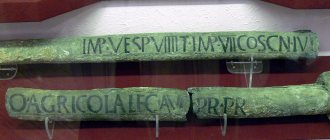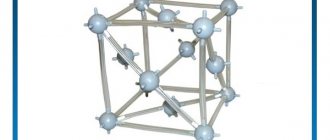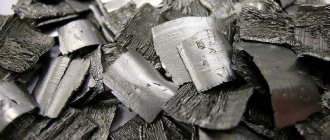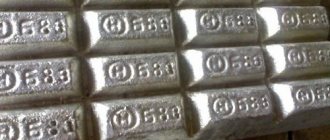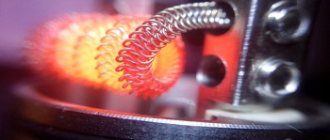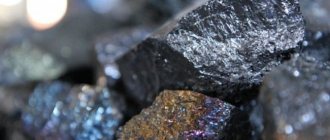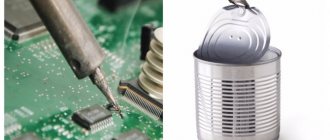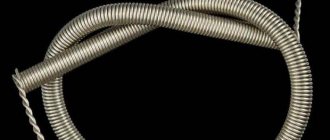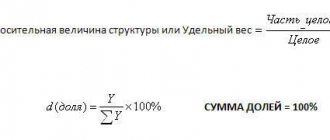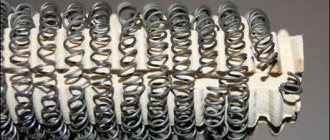Nichrome alloys
were in use as early as 1900, and they were successfully used in heating systems. Consequently, real-world, hands-on experience with equipment and industrial furnaces provides confidence in the use of these alloys in advanced and established designs.
In this article you will find reference data and tables with the characteristics of various nichrome alloys. You can find a calculator for calculating the parameters of nichrome wire or fechral wire in our previous article “Calculation of nichrome and fechral for heaters.”
Compound
Nichrome contains about 20% nickel and up to 80% chromium.
In addition, the alloy may contain additives in the form of manganese, aluminum, iron, silicon, etc.
The introduction of alloys into the nichrome composition increases the performance indicators and technical parameters of the metal:
- nickel and iron improve machinability;
- iron, titanium, aluminum and manganese reduce resistance to elevated temperatures;
- In the presence of iron in the alloy, nichrome acquires magnetic properties.
Increasing additives can degrade the characteristics of the metal.
The amount of nickel determines the temperature that the heating elements can withstand.
The chromium content in the alloy should be no more than 20%. An increase in the amount of chromium increases the brittleness and impairs the machinability of the metal. When its content in the alloy is more than 30%, cold rolling and drawing of the material becomes impossible.
The strength of the protective film and oxidation resistance depend on the amount of chromium.
Properties of nichrome
The alloy is characterized by good ductility and high electrical resistance. Its value can range from 1100 to 1400 Ohm mm²/m, depending on the type of metal.
Table 1. Technical characteristics of nichrome.
| Options | Indicators |
| Strength | 650-700 MPa |
| Melting temperature | 1100-1400°С |
| Working temperature | 800-1100°С |
| Density | Up to 8200-8500 kg/m3 |
| Resistance | 650-700 MPa |
| Coefficient of thermal conductivity | 11.3 W/(m K) |
| Linear thermal resistance coefficient | 14·10¯⁶Kˉ¹ |
| Ultimate tensile strength | 0.65-0.70 GPa |
Products made from nichrome are easily deformed while maintaining the given shape.
Nichrome does not have magnetic properties, with the exception of an alloy that contains an iron alloy.
Figure 2. Heating element.
Nichrome specific gravity table
Since nichrome is a complex material, it is not possible to independently calculate its specific gravity in the field. These calculations are carried out in special chemical laboratories. However, the average specific gravity of nichrome is known and ranges from 8.1 to 8.4 g/cm3.
To simplify the calculations, below is a table with the values of the specific gravity of nichrome, as well as such an indicator as the weight of nichrome depending on the units of calculation.
Specific gravity and weight of 1 m3 of nichrome depending on units of measurement
| Material | Specific gravity (g/cm3) | Weight 1 m3 (kg) |
| Nichrome | From 8.1 to 8.4 | From 8100 to 8400 |
Nichrome brands
The most common brands in the industry include:
- X20N80 is a classic alloy containing about 20% chromium and 80% nickel;
- X15N60 - the alloy has reduced chromium and nickel content, increased iron content to 25%;
- Kh20N80-N (-N-VI) and Kh15N60 (-N-VI) - alloys produced in vacuum induction furnaces;
- N50K10, X25N20 - grades of nichrome used for work at temperatures up to 900°C.
Alloys produced in vacuum induction furnaces are distinguished by the fact that their electrical resistance changes little with temperature changes.
Explanation of brands:
- X – chromium (Cr);
- N – nickel (Ni);
The numbers indicate the percentage of the composition.
Additional letters mean:
- VI - vacuum induction melting;
- H - category of heating elements;
- C - use in resistance elements;
- Heating element - intended for dry type electric heaters.
For example, the brand X20N73YUM-VI indicates: chromium content - 20%, nickel - 73%, aluminum - 3%, molybdenum - 1.5%, manganese - up to 0.3%, titanium - up to 0.05%, iron - 2 %, carbon - up to 0.05%. The alloy was smelted using the vacuum induction method.
The purpose and properties of nichrome products are determined by the chemical composition of the alloy.
International designations
In the international names of nichrome you can find the following designations:
- Cronix 80;
- NiCr80/20;
- Nichrome V;
- Chromel A;
- HAI-NiCr 80;
- Ni80Cr20;
- Nikrothal 8;
- Resistohm 80;
- euronichrome.
European analogues of ferronichrome: NiCr60/15, Ni60Cr15, ChromelCN6, Nikrothal 6, Nikrothal 60, CroniferII, AlloyC.
Advantages and disadvantages
Nichrome alloys are characterized by high electrical resistance.
The resistivity of nichrome is 10 times higher than that of galvanized steel and 70 times higher than that of copper.
Other advantages include:
- high mechanical strength and hardness;
- heat resistance and absence of temperature deformation;
- low specific gravity and good ductility;
- resistance to corrosion and aggressive environments;
The material is easy to process: sharpening, stamping, welding, etc. It does not change its characteristics when exposed to high temperatures.
Due to its resistance to corrosion and aggressive external environments, the alloy has an almost unlimited service life.
The disadvantages of the material include high cost.
Reducing the percentage of chromium in the alloy makes the product cheaper, but also reduces the technical properties of the material.
Properties and characteristics of the alloy
Nickel-chromium metal shows that chromium is highly soluble in nickel with a maximum of 47% at the eutectic crystallization temperature of 1145C and drops to 30% at room conditions.
The introduction of small amounts (<7%) of chromium into nickel increases the sensitivity of the nickel-chromium alloy to oxidation due to a proportional increase in the rate of oxygen diffusion. This trend is reversed, when more than 7% chromium is added, the drop continues up to 30%, after which the oxidation process stabilizes.
With increasing chromium additions, there is a noticeable increase in the electrical resistivity of the conductor. The addition level of 20% chromium is considered optimal for elements operating in heating systems. This composition combines not only good electrical properties, but also strength ones. This metal has ductility, which makes it suitable for the process of drawing nichrome wire.
Here are some basic properties of nichrome.
- Color: has a silver-gray color.
- Specific gravity: 8.4 g/cm3.
- The density of nichrome is: 8400 kg/m3.
- The melting point of this substance is: 1400 C.
- The electrical resistivity at room temperature for this substance is: 1.0 × 10 -6 to 1.5 × 10 -6 ohm (Ω).
- Specific heat capacity measures the amount of heat required to change the temperature of a substance by a certain amount, usually 1 degree. The specific heat capacity of this substance is: 450 J/(kg*K).
- The modulus of elasticity is a mathematical representation of a substance or the tendency of an object to deform when a certain force is applied to it. The elastic modulus for nichrome is: 2.2 × 10 11 Pa.
- Thermal expansion is the property of a substance due to which it changes volume when exposed to heat. The coefficient of thermal expansion of nichrome is: 14 × 10 -6 / C.
- Operating temperature is defined as the T at which a mechanical or electrical device operates. The operating temperature for nichrome is: 900 C.
- The temperature coefficient mathematically represents the relative change in the physical properties of a substance when T changes by 1 Kelvin. The temperature coefficient of resistance for nichrome is 100 ppm/C at temperatures ranging from 25 C to 100 C.
- The substance is highly resistant to corrosion and resistant to oxidation at high temperatures.
Making wire and tape from nichrome
Almost all electric stoves and electrical appliances use nichrome wire, thread or tape as heating elements.
There are several ways to make products from nichrome:
- Wire and thread drawing with intermediate heat treatment. Immediately before drawing, wire rod with a diameter of 6-8 mm is heated in special furnaces to a temperature of 1170-1230°C and quickly cooled. The heating temperature of the workpiece depends on the composition of the alloy. The next stage is pickling the wire rod in a mixture of hydrochloric and nitric acid with water.
Nichrome wire drawing is performed using high pressure. The production of products by drawing method is regulated by the requirements of GOST 8803-89
- Drawing of a hot-rolled billet to obtain a nichrome strip. This method allows the output to be a high-quality strip that exactly matches the profile and cross-section of the drawing channel. The resulting tape is of high quality and has no sharp edges.
- Cold drawn broach. The method is used for the production of wire and threads from nichrome. It is carried out without preheating the workpiece. Regulated by GOST 12766.1-90
- Cold rolling. Used for making nichrome tape. Performed in accordance with the requirements of GOST 12766.2-90.
- Flattening - used to produce strips from precision alloys with high electrical resistance. Performed in accordance with GOST 12766.5-90.
Nichrome tape.
The dimensions, mechanical properties and other parameters of nichrome wire are regulated by state standards or technical specifications.
Nichrome alloy heating elements
Electric resistive heating element
has been used for a long period of time. Therefore, many designs have been improved to provide superior performance. It is important to check all the factors to create a heater that offers satisfactory functionality at an affordable price. To accomplish this task, the following factors must be considered:
- Mechanical influences
: If heated equipment is to be subjected to severe mechanical shock, the method of installing the heating elements must be of paramount importance.
- Temperature
: This is a major factor in selecting the alloy and size of heating material. The application of the heating element indicates the required temperature. It is also important to distinguish between ambient temperature and resistance wire temperature.
- Space Required
: The space introduced to install the heater is usually adjustable. This suggests that sufficient space may not be practical. To ensure even toasting of bread in a toaster, the material should be kept away from the surface, but there should be enough room for the equipment to move.
- Atmosphere
: Indicates that gases or solids are interacting with the heater. A protective layer in the oven or splashes in the fryer are usually detected.
- Temperature cycle
: The suitable operating condition for the heating element is
to maintain a constant temperature
. This is usually impractical. Laboratory tests have shown that at elevated operating temperatures, such as 800°C and above, a typical heater on has a long overall life. Due to the outstanding life of the non-cycling heater, many tests are designed for high cycling rates. Cycle time is determined by the duration required for the device to switch between the stabilized test temperature and room temperature. - Safety
: Safety precautions must be observed when working with devices that operate at high temperatures or with electrical conductors. Installing appliances behind fences may cause temperatures to rise more sharply than expected.
- Power Density
: An important factor to understand is power density, which is a number that expresses the power dissipated per unit area. Higher loads require higher temperatures. Selecting the maximum value is an appropriate design concept since it refers to the minimum amount of material, providing a cost-effective system with a suitable service life. This is achieved by a combination of the smallest conductor cross-section and suitable resistivity. In heating coils and furnace strips, self-heating between circuits is allowed by radiation from the coil turns.
Areas of use
High corrosion resistance, the ability to work in aggressive conditions, and high-quality technical characteristics allow the material to be used in various fields.
In industrial installations and electrical equipment:
- high temperature electric furnaces;
- ventilation dryers;
- boilers and heat exchangers;
- welders;
- single-core and multi-core electrical wires;
- structural elements of metal-smelting equipment;
- powder paint polymerization chambers;
- devices for cutting foam;
- resistors, rheostats.
Heating elements made of nichrome are installed in car cigarette lighters, glass and seat heating systems in cars.
Special grades of complex alloyed nichrome with a low coefficient of electrical resistance are used as a heat-resistant coating when performing thermal spraying.
At home
The material is used in almost all modern household appliances:
- electric stoves and ovens;
- heaters and boilers;
- washing machines and toasters;
- hair dryers and irons;
- electric soldering irons and wood burning devices;
- electronic atomizers and light bulbs.
The use of spirals in household electric stoves.
Nichrome threads are widely used in medicine as a suture material during intracavitary surgical and plastic operations.
For each application, certain grades of alloys with optimal technical characteristics are produced.
Application of nichrome
Nichrome is used in electric heaters for furnaces for all industries, household appliances and thermal devices. Widely used in high-temperature electric furnaces, roasting and drying furnaces, and various electrical thermal apparatuses. Used as heating and resistor elements. It has increased heat resistance, creep resistance, ductility and shape stability. Nichrome is also used as a heat-resistant (heat-resistant) alloy and a chemically resistant alloy in certain aggressive environments. In particular, nichrome grade X20N80 is a material for heating elements of industrial electric furnaces and various electric heating devices. It is recommended to use for heaters of electrothermal equipment of increased reliability. Nichrome X15N60 is used for the manufacture of the same products as X20N80 , and is also used in electronic products and in the creation of non-precision resistors.
What is Resistance Heating Alloy
Resistive materials are materials that heat up to high temperatures when current passes through them.
The reliability, quality and technical characteristics of heating elements depend on the composition of the material.
The main types of resistive alloys include:
- Nichromes are alloys of nickel and chromium.
- Ferkhali - alloys of iron, chromium and aluminum.
- Multicomponent alloys, in which, in addition to chromium, aluminum, iron, alloying elements are added - copper, manganese, silicon, titanium.
The melting point of multicomponent alloys is 1500°C, and the service life of heating elements is 2-3 times longer than nichrome products.
Characteristics of alloys for contact heating
To become an electric heating element, metal or alloys must have the following characteristics:
- Good high electrical resistance to maintain small cross-sectional area
- High strength and ductility at operating temperatures
- Low temperature coefficient of electrical resistance to prevent significant changes in resistance at operating temperature compared to room temperature.
- Excellent resistance to oxidation in air under moderate treatments
- Suitable work and potential to give the required shape.
Materials that have these properties are 80/20 Nichrome, 70/30 Nichrome, 60/15 Nichrome and 35/20 Nichrome. The properties of these alloys in air are assessed as follows:
| NiCr grade 80/20 | 70/30 NiCr | C Class 60/15 NiCr | D Class 35/20 NiCr | |
| Highest operating temperature in the air | 1200°C or 2200°F | 1260°C or 2300°F | 1150°C or 2100°F | 1100°C or 2000°F |
| Melting temperature | 1400°C or 2550°F | 1380°C or 2520°F | 1390°C or 2530°F | 1390°C or 2530°F |
| Specific gravity | 8,41 | 8,11 | 8,25 | 7,95 |
| Density | 8.415 g/cm³ | 8.11 g/cm³ | 8.249 g/cm³ | 7.944 g/cm³ |
| Tensile strength | 830 MPa or | 900 MPa | 760 MPa | 620 MPa |
| Yield strength, 0.2% | 415 MPa | 485 MPa | 380 MPa | 345 MPa |
| Relative extension% | 240 MPa | 240 MPa | 240 MPa | 240 MPa |
| Reducing area | 55% | 55% | 55% | 55% |
- Nichrome 80/20.
The most popular resistance alloy, consisting of 80% nickel and 20% chromium, is still widely used, however various studies have suggested some improvements in basic chemical properties. Nominal amounts of iron, manganese and silicon are included, as well as small contents of rare earths and others, allowing the alloy to be used at temperatures up to 1200 °C or 2192 °F.
- Nichrome 70/30
provides extended service life in air at temperatures up to 1260°C or 2300°F. It provides outstanding oxidation resistance under low oxygen conditions, a mechanism known as green rot due to the green tint of the oxide.
- Nichrome 60/16 iron 24
. A nichrome alloy consisting of 60% nickel and 16% chromium and 24% iron is usually selected when the application temperature must not exceed 1100 °C.
- Nichrome 35/20 iron 45
. The alloy, consisting of 35% nickel, 20% chromium and iron, is used in industrially controlled furnaces operating at temperatures between 800 °C and 1000 °C. It makes a significant contribution to preventing damage that can occur in the above two alloys , when the operating temperature is the same, but the conditions differ between reduction and oxidation. Nichrome A or 80/20 is not recommended for use in conditions that reduce nickel and oxidize chromium.
All heating alloys mentioned in the table above have a long service life
as heating material if they are designed accordingly with suitable wire size and coil specification.
Suitable heating element life begins with the production of the alloy and the subsequent results resulting from proper care of the alloy - wire, tape, strip - when it is formed as a heating element and installed in the equipment.
Resistivity of nichrome and other alloys for heaters
Electrical resistivity determines the ability of a metal to prevent the passage of current. It is calculated as the ratio of the electric field to the current density and is measured in Ohm mm²/m.
Table 2. Resistivity of main alloys suitable for heating elements.
| Alloy | Resistivity | |
| ||
| 80 – Nickel, 20 – Chrome | 1.0803 Ohm mm2/m | |
| 80 – Nickel, 20 – Chrome | 1.18002 Ohm mm2/m | |
| 35 – Nickel, 20 – Chrome, 45 – Iron | 1.01382 Ohm mm2/m | |
| ||
| 73 – Iron, 22 – Chrome, 5 – Aluminum | 1.45425 Ohm mm2/m | |
| 74 – Iron, 22 – Chrome, 4 – Aluminum | 1.35453 Ohm mm2/m | |
| 81 – Iron, 15 – Chrome, 4 – Aluminum | 1.35453 Ohm mm2/m | |
| ||
| 55 – Copper, 45 – Nickel | 0.4986 Ohm mm2/m | |
| 89 – Copper, 11 – Nickel | 0.1495 Ohm mm2/m | |
| 98 – Copper, 2 – Nickel | 0.0498 Ohm mm2/m | |
The main factors in choosing an alloy for the manufacture of heaters are the combination of high electrical resistance and the ability to withstand extremely high temperatures for a long time.
What is nichrome
Nichrome alloy has good ability to resist electron flow. These unique properties make it suitable for applications in heating elements of hair dryers and heat guns. It has high oxidation resistance, which also makes it a suitable material for heating technology. Nichrome wire is wound into coils with a specific electrical resistance of nichrome through which a current is passed to produce heat.
Nickel-chromium 90/10 alloy is used in thermocouples in combination with Ni/Al 95/5 alloy. This combination is called chromel-alumel, represents heating elements with a maximum operating temperature of 1100 C and is subject to drift in the region of 1000 C due to oxidation. This effect is eliminated by adding silicon. Commercial grades include Nicrosil (containing 14% Cr and 1.5% Si) and Nisil (containing 4.5% Si and 0.1% Mg).
What does nichrome look like?
Nickel-chromium 80/20 metal is a high-temperature corrosion-resistant alloy used for wrought and cast parts because it has better resistance to oxidation and hot corrosion than cheap iron-nickel-chromium alloys.
Calculation of an electric spiral made of nichrome
The parameters of the spiral can be calculated using electronic calculators on the manufacturers’ website. By specifying the heater power, supply voltage and wire diameter, you can calculate the length of wire required for the heater coil.
Resistance calculation
It is calculated based on the diameter of the wire used or the cross-sectional area of the tape.
The total length of the wire is multiplied by the resistivity of one meter of conductor with the appropriate cross-section.
If the brand of alloy is known, the resistivity of the wire is taken from tables located in technical reference books, GOST or on the Internet.
If the alloy grade is unknown, the performance of the wire or finished spiral can be measured with a multimeter.
Using an online calculator, you can make a preliminary calculation of the spiral, but to accurately calculate the parameters of the heater, many more factors should be taken into account.
Nichrome spirals.
Length calculation
The length of the nichrome spiral depends on the resistivity and diameter of the wire and is determined by the formula: L=(Rπd2)/4ρ.
- R – wire resistance;
- d – wire diameter;
- ρ – resistivity of nichrome;
- π – constant = 3.14.
We take ρ nichrome from the table GOST 12766.1-90: ρ=1.0÷1.2 Ohm mm2/m.
Table 3. The relationship between current strength, diameter and cross-section of nichrome.
| Permissible current (I), A | 1 | 2 | 3 | 4 | 5 | 6 | 7 |
| Diameter (d) of wire at 700°C, mm | 0,17 | 0,3 | 0,45 | 0,55 | 0,65 | 0,75 | 0,85 |
| Wire cross-section (S), mm | 0,0227 | 0,0707 | 0,159 | 0,238 | 0,332 | 0,442 | 0,57 |
Example:
It is necessary to calculate the length of the wire for the spiral of the electric stove.
Tile power P = 800 W.
Mains voltage U=380 V.
Solution:
- We determine the current strength: I = P/U = 800/220 = 3.64 A.
- We determine the wire resistance R = U/I = 220/3.64 = 61 Ohm.
- Based on these data (see Table 3), we select d=0.55 mm; S=0.238 mm.
Then the wire length l = SR / ρ = 0.238 61 /1.1 = 13.2 m = 13,200 mm.
- L—wire length (mm);
- S—wire cross-section (mm);
- R—wire resistance (Ohm);
- ρ - resistivity (for nichrome ρ=1.0÷1.2 Ohm mm²/m).
Nichrome, Fechral
Nichrome alloys X20N80 and X15N60 are alloys with high electrical resistance. Х20Н80 and Х15Н60 are widely used and are used for the manufacture of electric heating elements that operate for a long time in air at temperatures of 1000-1300 °C, wire and tape resistors, and rheostat elements. Nichrome is a heat-resistant alloy, has a low temperature coefficient of electrical resistance, high electrical resistance and high resistance to corrosion under the influence of air or other gaseous media at high temperatures. It also has satisfactory manufacturability (cold ductility, weldability) - nichrome can be used to produce wire , tape , strip , rods and other semi-finished products; sufficient heat resistance - the ability to withstand mechanical loads without significant deformation, without collapsing at high temperatures. On the surface of these alloys, oxides are formed that are stable at high temperatures. The oxide film has a high density. These two factors provide high heat resistance of nichrome X20N80 and X15N60 . Fechral alloy also belongs to alloys with high electrical resistance and is also characterized by the above properties and applications. But fechral is an iron-chromium-aluminum alloy, nichrome is a chromium-nickel alloy. Х20Н80 and Х15Н60 tape , strip and thin nichrome wire can be made ). These alloys are more heat-resistant than ferchral , but unlike the latter they contain scarce and expensive nickel. Fechral is cheaper than nichrome and is characterized by increased heat resistance, but it is harder and more fragile than nichrome fechral wire cannot be made ). Among various products, the most widely used are nichrome wire , tape , nichrome strip X20N80 and X15N60 and fechral wire X23Yu5T . Wire is a semi-finished product with a cross section of constant dimensions, rolled into a coil or wound on a spool, produced by rolling, pressing or drawing (according to GOST 25501-82). Tape is a semi-finished rectangular cross-section with a thickness of over 0.1 mm in rolls, produced by rolling or electrolytic method (according to GOST 25501-82). Strip is a flat semi-finished product of rectangular cross-section with a length-to-width ratio of at least 5, a thickness of over 0.1 mm, produced by rolling or cutting sheets and strips (according to GOST 25501-82). Fechral and nichrome wires are divided according to purpose (according to GOST 12766.1-90) from alloys of grades X23YU5T :
- for heating elements - N
- for tubular electric heaters - heating elements
- for resistance elements - C
from alloys of grades Х20Н80-Н , Х15Н60-Н :
- for heating elements
- for tubular electric heaters - heating elements
from alloys of grade X15N60 :
- for resistance elements
Specific electrical resistance of nichrome (nominal value) - (according to GOST 12766.1-90)
| Alloy grade | Diameter, mm | Specific electrical resistance ρnom, µOhm m |
| Х20Н80-Н | from 0.1 to 0.5 incl. | 1,08 |
| from 0.5 to 3.0 incl. | 1,11 | |
| St. 3.0 | 1,13 | |
| Х15Н60, Х15Н60-Н | from 0.1 to 3.0 incl. | 1,11 |
| St. 3.0 | 1,12 | |
| Х23У5Т | All diameters | 1,39 |
Maximum recommended operating temperatures of heating elements operating in air (according to GOST 12766.1-90)
| Alloy grade | Maximum operating temperature of the heating element, °C, depending on the wire diameter, mm | ||||
| 0,2 | 0,4 | 1,0 | 3,0 | 6.0 or more | |
| Х20Н80-Н | 950 | 1000 | 1100 | 1150 | 1200 |
| Х15Н60-Н | 900 | 950 | 1000 | 1075 | 1125 |
| Х23У5Т | 950 | 1075 | 1225 | 1350 | 1400 |
Electrical resistance of nichrome wire and tape X20N80
Electrical resistance is one of the most important characteristics of nichrome. It is determined by many factors, in particular the electrical resistance of nichrome depends on the size of the wire or tape, and the grade of the alloy. The general formula for active resistance is:
R = ρ l/S
R - active electrical resistance (Ohm), ρ - specific electrical resistance (Ohm mm), l - conductor length (mm), S - cross-sectional area (mm2)
| Electrical resistance values for 1 m of X20N80 nichrome wire | ||
| № | Diameter, mm | Electrical resistance of nichrome (theory), Ohm |
| 1 | Ø 0.3 | 15,71 |
| 2 | Ø 0.4 | 8,75 |
| 3 | Ø 0.5 | 5,60 |
| 4 | Ø 0.6 | 3,93 |
| 5 | Ø 0.7 | 2,89 |
| 6 | Ø 0.8 | 2,2 |
| 7 | Ø 0.9 | 1,70 |
| 8 | Ø 1.0 | 1,40 |
| 9 | Ø 1.2 | 0,97 |
| 10 | Ø 1.5 | 0,62 |
| 11 | Ø 2.0 | 0,35 |
| 12 | Ø 2.2 | 0,31 |
| 13 | Ø 2.5 | 0,22 |
| 14 | Ø 3.0 | 0,16 |
| 15 | Ø 3.5 | 0,11 |
| 16 | Ø 4.0 | 0,087 |
| 17 | Ø 4.5 | 0,069 |
| 18 | Ø 5.0 | 0,056 |
| 19 | Ø 5.5 | 0,046 |
| 20 | Ø 6.0 | 0,039 |
| 21 | Ø 6.5 | 0,0333 |
| 22 | Ø 7.0 | 0,029 |
| 23 | Ø 7.5 | 0,025 |
| 24 | Ø 8.0 | 0,022 |
| 25 | Ø 8.5 | 0,019 |
| 26 | Ø 9.0 | 0,017 |
| 27 | Ø 10.0 | 0,014 |
| Electrical resistance values for 1 m of X20N80 nichrome tape | |||
| № | Size, mm | Area, mm2 | Electrical resistance of nichrome, Ohm |
| 1 | 0,1×20 | 2 | 0,55 |
| 2 | 0,2×60 | 12 | 0,092 |
| 3 | 0,3×2 | 0,6 | 1,833 |
| 4 | 0,3×250 | 75 | 0,015 |
| 5 | 0,3×400 | 120 | 0,009 |
| 6 | 0,5×6 | 3 | 0,367 |
| 7 | 0,5×8 | 4 | 0,275 |
| 8 | 1,0×6 | 6 | 0,183 |
| 9 | 1,0×10 | 10 | 0,11 |
| 10 | 1,5×10 | 15 | 0,073 |
| 11 | 1,0×15 | 15 | 0,073 |
| 12 | 1,5×15 | 22,5 | 0,049 |
| 13 | 1,0×20 | 20 | 0,055 |
| 14 | 1,2×20 | 24 | 0,046 |
| 15 | 2,0×20 | 40 | 0,028 |
| 16 | 2,0×25 | 50 | 0,022 |
| 17 | 2,0×40 | 80 | 0,014 |
| 18 | 2,5×20 | 50 | 0,022 |
| 19 | 3,0×20 | 60 | 0,018 |
| 20 | 3,0×30 | 90 | 0,012 |
| 21 | 3,0×40 | 120 | 0,009 |
| 22 | 3,2×40 | 128 | 0,009 |
How to wind a spiral from nichrome
You can make a spiral from nichrome wire at home.
To do this, you need to select a wire of a suitable grade and calculate:
- wire length;
- spiral winding pitch;
- number of turns.
The length of one turn is determined by the formula:
l=π(D+d/2)=3.14(5+0.55/2)=32 mm.
Number of turns:
N=L/l=13 200/32=412 turns.
- d—wire diameter;
- L—wire length;
- I is the length of the turn;
- D is the diameter of the coiling rod.
The number of turns of wire when wound onto a tubular rod D=10 mm is 412 pcs.
In practice, they rarely wind spirals at home. It is easier to buy a heating element with the required parameters in a specialized store.
Homemade spiral winding.
Calculation of nichrome spiral
Resistance calculation method
First, let's take a closer look at calculating the length of nichrome wire based on power and electrical resistance. First, you need to decide how much power the heating coil will need. Let's say we need to make a small heater for a device with a power of 10 W and a voltage of 12 Volts. Let's say we have nichrome wire with a cross-sectional diameter of 0.1 mm.
The most basic calculation, without taking into account heating, is made according to the formula familiar to us from a school physics course:
Р=U∙І → І = Р/ U = 10/12 = 0.83 A
According to Ohm's law:
R= U/ I = 12 / 0.83 = 14.5 Ohm.
Knowing the cross-sectional area of the wire (S) and the resistivity of nichrome (ρ), we can calculate the length of the wire that we will need to make the spiral:
І = S∙ R/ ρ
In order to find out the resistivity of nichrome wire of a certain diameter, you can use formulas or a ready-made table of values. For nichrome with a diameter of 0.1 mm, the resistance will be 14.4 Ohms and the cross-sectional area will be 0.008 mm2, then by substituting the values in the formula we will get a wire length equal to 10 cm.
To calculate how many turns of a spiral need to be made from a wire of the obtained length, you need to use the following formulas:
Let's calculate the length of one turn equal to:
Turn length =π∙(winding diameter + 0.5 ∙ wire cross-section diameter)
Number of turns = wire length / turn length
Thus, if the winding diameter of our wire is 2 mm, then
Number of turns = 100/(3.14*(2+0.05))=15.5 turns
Theoretical calculations are, of course, good. But will nichrome with such a cross-sectional diameter withstand such a current in practice? The tables provided below show the maximum current that is allowable for certain diameters of nichrome filament at a given temperature. To put it simply, you need to determine the temperature to which the spiral heating element should be heated, and select its cross-section for the design current from the table.
If the heater will be used in a liquid environment, the current strength can be increased by 1.2-1.5 times, and if it will heat a closed space, then its current should be reduced.
Temperature calculation method
The simple calculation described above is not accurate enough due to the fact that we take the resistance value of the spiral in a cold state. But as the temperature changes, the resistance of the material also changes. It should also be taken into account what the conditions are for achieving this temperature. For low temperatures, for example in heaters, the first calculation method can be used freely, but for high temperatures in resistance furnaces this method will be too approximate.
Let's calculate the spiral for a muffle furnace using the second method. First you need to calculate the volume of the chamber and, based on it, the heating power. For muffle furnaces there is the following selection rule:
- For ovens with a volume of up to 50 liters, the power is taken at the rate of 100 W per liter
- For furnaces with a volume of 100 to 500 liters, the power is taken at the rate of 50-70 W per liter
Let's take as an example a small oven with a volume of 50 liters, then the power of the oven should be 50 * 100 = 5000 W
Let's calculate the current (I) and resistance (R) for a supply voltage of 220V
I = 5000/220 = 22.7 A
R = 220/22.7 = 9.7 Ohm
If you connect spirals at 380 V using the star connection method, you need to divide the power into 3 phases, so we will have
Power per phase = 5 kW / 3 = 1.66 kW
With this type of connection to a three-phase network, 220 V will be supplied to each phase, respectively, the current and resistance will be equal:
I = 1660/220 = 7.54 A
R = 220/7.54 = 29.1 Ohm
If the connection of spirals at a voltage of 380 is made using the “triangle” method, the calculation formulas will take into account the linear voltage of 380 V.
I = 1660/380 = 4.36 A
R = 380/4.36 = 87.1 Ohm
The diameter can be calculated taking into account the specific surface power of the heater. Let's calculate the length of the heating filament, taking the resistivity from the tables.
Surface power = βeff*α(efficiency factor)
Thus, in order to heat a muffle furnace to a temperature of 1000 degrees, we need a spiral heated to 1100 C. Using the tables, we select the appropriate values and get:
Surface power (Vdop)=4.3∙0.2=0.86 W/cm2=8600 W/m2
The diameter is determined by the formula d= 3 √((4*Rt*P 2 )/(π 2 *U 2 *V add ))
The resistivity of the material at the desired temperature (Rt) is taken from the table
If we have nichrome grade X80H20, Rt will be equal to 1.025. Then Рт=1.13*106*1.025=1.15*106 Ohm per mm
For star connection: diameter = 1.23 mm, length = 42 m
Let's check the values using the formula L=R/(p*k)
We get 29.1/(0.82*1.033)= 34 m
Thus, we see that in the formula without taking into account temperature there is a significant difference in the obtained values. It is correct to choose the length of one spiral for star connection equal to 42 m, then for 3 spirals you will need 126 meters of nichrome wire with a diameter of 1.3.
Conclusion
Based on formulas and a calculator, you can quickly calculate the length of nichrome or fechral wire and calculate its diameter based on the required power and temperature of the heating element, but even the second, more complex calculation method does not take into account a number of factors. In practice, after theoretical calculations have been made, it is necessary to manipulate the results based on the characteristics of the use of the heater.
For accurate calculations of the length of fechral and nichrome spirals, as well as for advice on heating elements, please contact our specialists by phone or email. From us, in addition to ready-made industrial heaters, you can also purchase components for their creation, including fechral wire and tape, heat-resistant wires, ceramic insulators, micanite, heat-resistant connectors, etc.
Temperature coefficient of resistance
The resistivity of an alloy changes when the material is heated or cooled.
The temperature coefficient of resistance (TCR) of nichrome is defined as the ratio of the change in electrical resistance to the change in temperature in degrees Kelvin, taken to the minus of the first power (Kˉ¹).
TKS of nichrome is determined by the formula: α= (R1 - R2) / R1 X (T1 - T2), where:
- R1 is the resistance value at the initial temperature;
- R2 - at final temperature;
- T1—initial temperature;
- T2—changed temperature;
- (R1 - R2) - difference in electrical resistance;
- (T1 - T2) - temperature difference.
Heating by 100°C increases the electrical resistance of nichrome by 2%.
Nichrome 60 vs Nichrome 80
The properties of nichrome are determined by the quantitative ratio of nickel and chromium in the alloy.
The more nickel in the alloy, the higher its maximum operating temperature:
- for nichrome X20N80 this figure is 1200°C;
- for alloy X15N60 - up to 1125°C.
The next important indicator is plasticity. It affects the machinability of the metal.
Nichrome 60 alloy was created by reducing the amount of nickel in the alloy and increasing modifying additives to reduce the cost of heaters.
The use of the more expensive X20N80 alloy is justified when operating devices at extremely high temperatures.
Cost of nichrome
Based on geography, the global nichrome alloy market can be classified into Asia Pacific, Europe, North America, Latin America, and the Middle East and Africa. North America and Europe are the main markets for nichrome alloys, driven by the growth of the aerospace and electronics industries. Nichrome manufacturing companies in Asia Pacific and Latin America are investing heavily in nichrome research and development in Asia.
The cost of nichrome products in the form:
- Wire 0.8 mm Х20Н80 – 1,990 rub./kg;
- Wire 2.0 mm Х20Н80 -2,050 rub./kg;
- Tape #1.0x15 mm Х20Н80 – 1,990 rub./kg;
- Nichrome wire 1.5 mm X15N60 – RUB 1,590/kg.
Nichrome Bibus Metals
The major players operating in the global nichrome alloys market are American Elements, Bibus Metals, VDM Metals, Crown Alloys, Wickeder Westfalenstahl GmbH, Tri Star Metals and others. These companies constitute a significant share of the nichrome alloys and scrap market, thus the market is highly competitive.
Russian producers of nichrome: Volgograd Steel Wire Rope Plant, GRACE-1000 (Moscow), Western Ural Industrial Supply (Perm), Index-VK (Ekaterinburg), Kamensk-Uralsky Plant, Metallokomertsiya (Moscow), Prommet (Moscow), Promsnabmetall AG (Moscow ), Ural Precision Alloys Plant.
Effect of temperature and processing on resistivity
Thanks to the resistance of the metal opposing the flow of electricity, nichrome heaters generate heat.
Indicators may vary depending on various factors:
- Alloy temperatures. When the temperature increases from 20°C to 650°C, the resistivity increases by about 8%.
- Manufacturing and processing methods. The resistance changes after annealing and rapid cooling:
- Х20Н80 – increase by 6%;
- Х30Н70 – increase by 4%;
- Х15Н60 – increase by 2%.
Alloy X20N35 resistivity practically does not change during processing and temperature changes.
The ability to change resistivity depends not only on the alloy composition, but also on the cross-sectional size of the heater. Elements of a smaller cross-section react more strongly to changes in the temperature of the alloy than massive parts.
Soldering nichrome
With prolonged use of electric heating devices or overheating, the nichrome spiral may burn out.
You can connect elements made of nichrome to each other, as well as to steel, copper or their alloys by soldering, using tin-lead solder POS 50 or POS 61.
In addition, a flux is used from a mixture of technical petroleum jelly (100 g), glycerin (5 g) and zinc chloride powder (7 g), mixed to a pasty state.
Soldering is performed in the following order:
- the elements to be connected are cleaned with abrasive sandpaper;
- degreasing is performed using a ten percent alcohol solution of copper chloride;
- parts are treated with flux;
- the ends of the wire are tinning;
- soldering is in progress.
Tinning can be done using regular citric acid. To do this, a small amount of it is poured onto a wooden stand, the stripped ends of the parts to be joined are placed on the powder and heated with a soldering iron. The acid melts, covering the metal surface with a thin layer.
To remove residual citric acid, the ends of the wire are tinned again using rosin.
Soldering is performed using POS 40/50/61 solders.
Repairing a burnt-out nichrome spiral using solder is not suitable for devices whose heating exceeds 300°C.
Nichrome soldering.
How can I replace nichrome thread?
A modern analogue of nichrome is fechral (FeCgAl) - an alloy of iron, chromium and aluminum.
Fechral heaters are used in mechanical engineering, foundry industry, glass and ceramics production, and other industries.
The material is supplied in the form of wire, thread, spirals of various diameters or ready-made heating elements.
The advantages of fechral heaters compared to nichrome ones include:
- no scale;
- lower density;
- longer service life (2-4 times);
- the cost is 2-3 times lower than nichrome.
Protection of fechral heating elements is provided by aluminum film. When working in a non-oxidizing environment, the protective film should be restored by annealing in air (in an oxidizing environment).
At temperatures above 900°C, the metal becomes grainy and brittle.
Fechral heating elements must be placed on ceramic tubes, since at temperatures above 800°C the spirals can deform even under their own weight.
Fechral wire 0.5 mm X23Yu5T.
Chemical composition of nichrome (X20N80, X15N60). Nichrome rental
According to GOST 10994-74, the chemical composition of nichrome X20N80 : chromium content Cr 20.0-23.0%, nickel Ni - the rest, iron Fe - no more than 1.5%, aluminum Al - no more than 0.20%, titanium Ti - no more than 0.30%, etc. In total, these elements, together with chromium, reach a maximum of 27.35%. In nichrome X15N60 according to GOST, the nickel content is 55.0-61.0%. Nichrome: wire , tape , circle, sheet. X20N80 wire of various sizes has become especially widespread .
Nichrome insulation with silicone multi-core cable
Heat-resistant heating cable in silicone insulation based on X20N80 tape or wire is used in various heating systems and thermal treatment installations.
To insulate nichrome wire or tape, two-layer silicone insulation is mainly used.
The basis of the insulating material is silicone rubber, obtained on the basis of high molecular weight organosilicon compounds. In appearance, the insulation is similar to ordinary rubber, but differs from it in higher technical indicators:
- resistance to high voltages - breakdown voltage is 5,000 Volts;
- resistance to aggressive environments and atmospheric influences;
- fire resistance - the material does not burn and does not emit toxic smoke when burned;
- operating temperatures from -60°С to +180°С;
- increased strength and durability.
Silicone insulation can withstand short-term temperature increases up to 220°C without changing the structure and quality of the coating. It is not destroyed by ultraviolet and radioactive radiation. Does not lose its qualities under the influence of ionizing radiation up to 20 Mrad (20 x 106 kJ/kg).
For the manufacture of heat-resistant heating cables, mainly two-layer silicone insulation is used.
Nichrome in isolation.
Scope of application
Based on application, the global nichrome alloy market can be segmented into architectural, automotive, electronics, aerospace and others. Nichrome alloys are used to make monel from iron and steel, to produce stainless steel. Nichrome alloys are used for architectural purposes such as lead for water pipes, roofing and windows.
Nichrome is used in gears, driveshafts, and special vehicles for operating in areas with low temperatures or heavy wear. It is also used for special engineering purposes. Nichrome alloys are primarily used for electrical resistance heating. They have high electrical resistance, good strength and ductility at operating temperatures.
Nichrome is widely used in the fireworks and explosives industry and to prepare wires for electrical ignition systems such as lighters, electric matches and electronic cigarettes.
This substance is used in ceramic works. It serves to provide internal support structure and helps keep the shapes of clay sculptures soft. Because of its resistance to high temperatures, it is used when pieces of clay are fired in kilns. Nichrome wires are used to test the flame color in unlit parts of a cationic fire for sodium, copper, potassium and calcium cations.
Nichrome is also used in microbiology laboratories and to make thermocouples.
Operating requirements
To ensure a long service life of nichrome products, it is important to follow certain rules:
- to prevent overheating, winding the heating cable on the frame in several layers is not allowed;
- the bend of the current-carrying core in the cable should not exceed five of its diameters.
The integrity of the conductor can be restored by mechanical twisting, threaded clamps or couplings, soldering or welding.
When you turn on a device with a nichrome heating cable for the first time, a small amount of smoke may be released due to the burning out of residual oil.
Nichrome spiral
